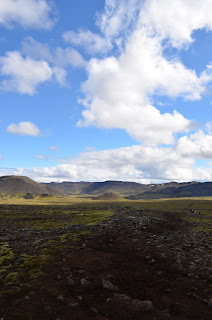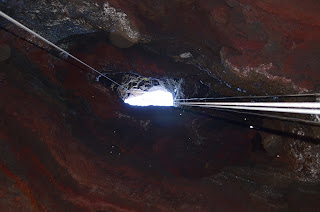As eruptions occur approximately every 3-4 years on average
in Iceland (some say it’s more like 10 years) it seemed like a good idea to
explore as much volcanic attractions as possible (and safe) whilst here. So what better than descending 120 metres
into a dormant volcano and having a little peak around in the vault below. After getting a little bit of buyers regret
once I’d booked the tour this experience had become the thing I really focused on
for this trip…and it surpassed all my expectations.
I owe the Weather God a small sacrifice as offering of
thanks due to the amazing day we were greeted with on the day of descent. All I’ve heard since I’ve arrived is that
this summer has been horrifically wet (especially in the South) but what
greeted me was “the best day of summer” (quote from tour guide). On arrival at the booking station I met the
small cluster of souls that were braving the trip with me and they were all as
excited, expectant and terrified as I.
The ‘Inside the Volcano’ tour has only been operational for 2 summers
and everything that accompanies the tour is flown in at the beginning of summer
and flown out at the end (in about 2 weeks from now). With only 4 descents a day and a maximum of
15 people per descent it became apparent this was something very few people are
ever going to get the chance to do and it dawned on most of us that this was
pretty special.
On arrival in the “Blue Mountains”, which is the South’s
skiing field, approximately a 50 minute drive out of Reyjkavik we were met by our guide (suitably blonde and
stubbled) who announced we’d be trekking across the moss laden lava field to
the tour’s Base Camp. The walk itself is
not strenuous due to height grade but it’s treacherous as you navigate the lava
rocks for 50+ minutes (so glad my walking boots accompanied me). The group mainly consisted of older Brits
which I found really puzzling as they struggled to make the walk little own the
descent. Maybe this has to do with the
expense of the trip which potentially precludes a lot of budget travellers but
myself and a young couple from Texas were the youngest on the tour. With over 300 kinds of moss located all over
Iceland the greenscape that greets you as you trek across the lava rocks is
bewildering and hypnotic.
Arriving at Base Camp , located a short ascent from Thrihnukagigur’s opening, we were greeted by our incredibly friendly base camp leader who introduced us to the camp’s adopted Arctic Fox, Flame. The little fox was abandoned by its mother and adopted the Base Camp staff as its pseudo parents – it cheerfully mingles with the crowd seemingly happy for the company and spare bit of food. Interestingly the fox scavenges as much as she can (mittens, scarves etc) preparing for the winter so we’re encouraged to ensure all our lose items are stored in our bags.
Thrihnukagigur translates to mean “Three Peaked” and one of
the three peaks contains a small opening from which the descent into the dormant
volcano is possible. Having been
dormant for over 4000 years Thriknukagigur contains one of the only fully
intact magma chambers and the 120 metre drop into the chamber is equal parts
terrifying and exhilarating. In groups
of 5 (of course I was in the first group) we were harnassed, hard-hatted and
asked to “walk the plank” out into the volcano opening’s centre and climb down
a small ladder into a window washer’s crate.
Once on board and with a push of a red button (how hi-tech) the descent began. The opening at the top is quite small and
the crate requires a shift in speed as it descends past some of the tighter
spots (wheels on the side of the crate assist on stabilising the cage as it
squeezes through) but once passed the tight entrance the shaft opens into a
large bowl like chamber.
The photographs of the chamber do not do it justice as the
reds, blacks, oranges and greys of the chamber don’t come out that well on
film. Allowed a half hour to explore the
chamber the group is asked to stay in-front of the orange rope (the drop zone
for anything that may fall from above) and behind the white rope (as parts of
the chamber descend even further into yet unexplored territory). Ummmm – sure happy to stay between the
ropes. And so you’re left alone to
clamber over the massive rocks contained in the chamber, touch the walls where
magma has attempted to blast its way out and quietly take in the magnitude of
the experience. Staying a constant 4
degrees all year round the chamber is dank and gloomy as glacial water thumps
down in huge dollops on you from on high and making the boulders slippery and
tricky to scale in places. The sense of
vertigo experienced as you look up is something I’ve never experienced and I
actually lost my footing and fell due to the giddiness (apparently I’m not the
only one to do so). The half hour of
exploring goes quickly but I’m not sure you’d need more and once on board the
crate we’re hoisted back to the surface.
Back at base camp we’re greeted with a bowl of the hearty
traditional Icelandic lamb soup (almost living on it), with little Flame trying
to get a sneaky piece, which is much needed knowing the hour trek back across
the lava field is required.
Icelandic Fast Facts
·
Sheep roam freely all spring and summer over
Iceland meaning that the lamb is truly free range (and delicious)
·
The
Icelandic moss is incredibly sensitive and once damaged can take between 30 –
50 years to repair itself
·
The “Inside the Volcano” experience also has a
helipad and I was lucky enough to see a helicopter landing onto the moss-strewn
lava field on the day of descent
Traveller Fact
·
Just because you think you’re farting quietly
does not mean you are (to the Brittish man who kept letting it rip in front of
the group) best to move away from the group before allowing the vapour out.








No comments:
Post a Comment